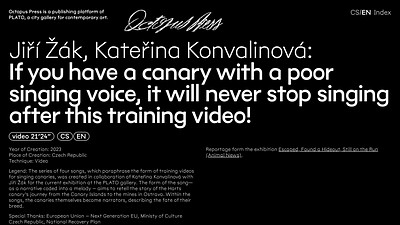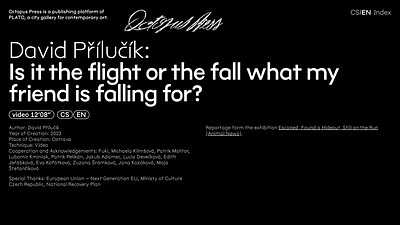Checking the Stove
- video
- 5’34”
- 0’40”
- cs
- en
Year of Creation: 2023
Place of Creation: Ostrava
Technique: Videoinstallation, two-channel video
Legend: The artist filmed turkeys on a semi-abandoned farm in Ostrava-Polanka nad Odrou and goats and sheep on the Duběnka farm. She compares their nervous behaviour in front of the camera to human obsessive-compulsive disorders, for example, constantly checking that appliances are switched off. The moving image work collages material from Eriksson's early video, 'Ett Familjeprojekt (1997), filmed with her children and punctuated by her question,“are you filming us now?” Same as the disorder the film footage repeats ad nauseum.
In collaboration with IASPIS, the Swedish Arts Grants Committee´s International Programme for Visual and Applied Arts
Special Thanks: European Union – Next Generation EU, Ministy of Culture Czech Republic, National Recovery Plan
Reportage form the exhibition Escaped, Found a Hideout, Still on the Run (Animal News).
Annika Eriksson is a Swedish artist who lives mainly in Berlin. During her residency in Ostrava she met many domesticated, semi-domesticated, feral and free animals and animal families. She talked with seagulls and storks at the OZO Ostrava landfill, with domesticated animals at the Duběnka farm in Hrabová, visited the inhabitants of a semi-abandoned farm in Ostrava – Polanka nad Odrou, a pigeon flock at the mall, and others. Of all the more-than-human beings Annika met, she brought a semi-free-living community of turkey hens and cocks to PLATO. She presents a double projection of the film in a specific installation, which is related in content to the temporality of the “liberated” farm. The artist has dealt with similar situations of animals and humans before, for example in a video in which a long shot follows a group of street dogs in the suburbs of Istanbul. The dogs, who have been relocated by the authorities to outlying areas outside of the expanding city, constantly move along the lines of gentrification and corporate development of the city. Through loops and repetition, the video links this process to the experience of time: it explores the present as a complex gap between past and future, in which an increasing process of erasure also removes other registers of being and seeing. Another video shows a group of formerly domesticated cats living together in a public park in Istanbul, their nocturnal activities and the people in the surroundings who take care of them during the day. Seemingly trapped in a state of collective paralysis, the group of cats live in a precarious situation on the border between care and dependence. Annika Eriksson’s work questions perceptions of time, power structures and once accepted social visions. She plays with debates about the public sphere and the structures that regulate it, revealing how it changes and is subject to unexpected appropriations and inversions.
- Language
- Type
- Palate Cleanser2025
- cs
- en
text- 2,000 words
- Monika Pascoe Mikyšková: Memories that aren’t mine2025
- cs
- en
text- 500 words
- Kino Kosmos under the Cosmic Sun2025
- cs
- en
text- 9,800 words
- Kino Kosmos2025
- cs
- en
text- 3,700 words
- Dorota Jurczak: Pyk, Sciak etc.2025
- cs
- en
text- 1,500 words
- Sprouts2025
- cs
- en
text- 800 words
- Curatorial text for the exhibition by Petr Bosák, Robert Jansa and Adam Macháček2025
- cs
- en
text- 900 words
- Curatorial text for Martin Zetová's exhibition2025
- cs
- en
text- 1,100 words
- Cello & Piano2025
- cs
- en
audio - Primeval Forest, Garden and Wall2024
- cs
- en
- pl
text- 1,100 words
- Interview with Barbora Lungová2024
- cs
audio - Barbora Lungová and the gift of painting2024
- cs
- en
text- 1,400 words
- Julie in the Worlds of Fantasy. Marginalia.2024
- cs
- en
text- 1,600 words
- Pigeon newspaper2024text
- Workbook for children The Shell No. 32024
- cs
- en
text- 200 words
- Zvířecí kustodi – Bee2024
- cs
- en
video- 32’32”
- Animal Custodians – Rabbit2024
- cs
- en
video- 33’18”
- Animal Custodians – Owl2024
- cs
- en
video- 28’05”
- Animal Custodians – Fox2024
- cs
- en
video- 32’05”
- Animal Custodians – Deer2024
- cs
- en
video- 33’45”
- Animal Custodians – Pigeon2023
- cs
- en
video- 32’20”
- Animal Custodians – Raven2023
- cs
- en
video- 21’24”
- If you have a canary with a poor singing voice, it will never stop singing after this training video!2023
- cs
- en
video- 21’24”
- Checking the Stove2023
- cs
- en
video- 5’34”
- 0’40”
- Trust2023
- cs
- en
video- 7’03”
- Is it the flight or the fall what my friend is falling for?2023
- cs
- en
video- 12’08”
- Animal News2023
- cs
- en
text- 1,500 words
- Dan Walwin: Relief2023
- cs
- en
text- 1,000 words
- Ukrainian Culture at the Time of Russian Aggression2023
- cs
- en
text- 100 words
- Freely Accessible Books on the Topic of Ukrainian Culture at the Time of Russian Aggression2023
- cs
- en
text- 500 words
- They Thought We Were Alive and They Run Screaming2023
- cs
- en
text- 1,200 words
- On Renewed Land: Locating Ukrainian Destiny2023
- cs
- en
text- 1,900 words
- I Can Hear the Grass Grow2023
- cs
- en
text- 600 words
- Interview related to the exhibition Optimised Fables about a Good Life2022
- cs
- en
text- 900 words
- Interview related to the exhibition Optimised Fables about a Good Life2022
- cs
- en
text- 900 words
- Interview related to the exhibition Optimised Fables about a Good Life2022
- cs
- en
text- 700 words
- Interview related to the exhibition Optimised Fables about a Good Life2022
- cs
- en
text- 1,700 words
- Interview related to the exhibition Optimised Fables about a Good Life2022
- cs
- en
text- 1,000 words
- Interview related to the exhibition Optimised Fables about a Good Life2022
- cs
- en
text- 1,100 words
- Interview related to the exhibition Optimised Fables about a Good Life2022
- cs
- en
text- 900 words
- Interview related to the exhibition Optimised Fables about a Good Life2022
- cs
- en
text- 1,600 words
- Interview related to the exhibition Optimised Fables about a Good Life2022
- cs
- en
text- 900 words
- Interview related to the exhibition Optimised Fables about a Good Life2022
- cs
- en
text- 1,400 words
- The Night2022
- cs
text- 0 words
- Optimised Fables about a Good Life2022
- cs
- en
text- 800 words
- In the footsteps of the Greek underground II: Longing for deep time2022
- cs
- en
text- 7,200 words
- In the footsteps of the Greek underground I2022
- cs
- en
text- 12,800 words
- Elective Affinities: “Anarchism Without Adjectives”. On the Work of Christopher D’Arcangelo 1975–1979 with Dean Inkster and Pierre Bal-Blanc2022
- cs
- en
video- 58’01”
- Curatorial Control2022
- cs
- en
text- 2,500 words
- Ruins. Reconstruction of the past and construction of the future2022video
- 1h 14’43”
- Long Evening with Octopus Press2022
- cs
audio - Oh and Hah, Beauty, Ruin and Slack2021
- cs
- en
text- 900 words
- Our Living Ruins2021
- cs
- en
- pl
text- 3,100 words
- Troubling Time/s and Ecologies of Nothingness: Re-turning, Re-membering, and Facing the Incalculable2021
- cs
- en
text- 16,400 words
- Re/un/doing the Ruin2021
- cs
- en
text- 2,800 words
- Usableness of the list / Portfolio2021
- cs
- en
audio - Tied to Landscapes2021
- cs
- en
text- 800 words
- Tied to Landscapes2021video
- 9’49”
- A Small Encyclopedia of Improprieties2021video
- 12’18”
- Humans need not apply2021
- cs
- en
text- 900 words
- Poems2021
- cs
- en
text- 200 words
- Carbon Care2021
- cs
- en
text- 1,400 words
- Bouvard and Pécuchet. A Tragi-comic Novel of Bourgeois Life2021
- cs
- en
- fr
text- 12,300 words
- And Again G. F.2021
- cs
- en
text- 700 words
- On The Immortality of Art Institutions2021
- cs
- en
- pl
text- 1,500 words
- Expedition PLATO2021video
- 47’25”
- The Great Transformation. The Political and Economical Origins of Our Time2021
- cs
- en
text- 4,800 words
- Digestive Tract2021video
- 14’35”
- Notre Dame of Ruins2021
- cs
- en
- fr
text- 1,100 words
- Who is Afraid of Ruins?2021
- cs
- en
- pl
text- 1,300 words
- The Ruin2021
- cs
- en
- de
text- 3,000 words
- Zapomínání a infrastruktura2021video
- 13’19”
- Forgetting and infrastructure2021
- cs
- en
text- 2,000 words
- Olympia2021image
- Purification II, 20202021video
- 3’35”
- Purification I, 20202021video
- 1’49”
- Chaos: how to ruin a ‘ruin’ and love a ‘ruin-in-love’, I think2021
- cs
- en
text- 5,400 words
- (Introduction) Chaos: how to ruin a ‘ruin’ and love a ‘ruin-in-love’, I think2021video
- 13’35”



